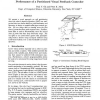Free Online Productivity Tools
i2Speak
i2Symbol
i2OCR
iTex2Img
iWeb2Print
iWeb2Shot
i2Type
iPdf2Split
iPdf2Merge
i2Bopomofo
i2Arabic
i2Style
i2Image
i2PDF
iLatex2Rtf
Sci2ools
ICRA
1999
IEEE
1999
IEEE
Performance of a Partitioned Visual Feedback Controller
We present a novel approach we call partitioning where the robot's degrees- of-freedom (D OF) are categorized into two classes based on joint kinematics and dynamics to design a coupled multi-input control system. We use image data to visually servo the first class of joints that have quick response time. Positionbased data is used to lcinematically servo the second class of joints that have large kinematic range. The net effect is an active-vision system that synergistically tracks a diverse range of targets (without using CAD-based models) over a wide bandwidth of motion dynamics.
| Added | 03 Aug 2010 |
| Updated | 03 Aug 2010 |
| Type | Conference |
| Year | 1999 |
| Where | ICRA |
| Authors | Paul Y. Oh, Peter K. Allen |
Comments (0)

